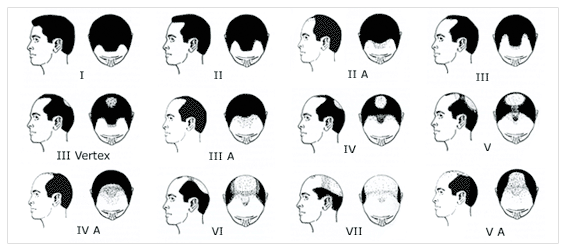It’s often said that a bad hair transplant is like herpes: You’ll carry it with you for the rest of your life. In this post, I’ll help you determine if hair transplantation surgery is a viable option for you.
Are You a Good Candidate for a Hair Transplant?
The answer to this question will depend on a variety of factors, including your age, degree of hair loss, and 6 more things. In this post, I’ll thoroughly review the 8 factors you should consider before you go under the proverbial knife. They include:
1. Your Age
How early is too early for a hair transplant? The answer to that question varies among doctors. 25 seems to be the approximate median age, as many surgeons prefer not to perform procedures on patients younger than 25 (source). I’ve also seen many doctors advise against transplants entirely in men under 30, as hair loss in younger men is often of the “aggressive” variety.
Note – Most men will start developing a mature hairline sometime in their late teens or early twenties. If your hairline hasn’t reached its mature point yet, a hair transplant will likely be ill-advised.

Most doctors will advise against hair transplants in men whose hairlines are maturing. To learn more, read my detailed post on the mature hairline.
2. Your Expectations
More than anything, a good hair transplant doctor wants to ensure his or her patients have realistic expectations. If you’re 24, working on a Norwood class 6 balding pattern, and want your hairline completely rebuilt in one procedure, most doctors won’t want to work with you. On the other hand, if you’re just starting to recede, with an early NW 3 pattern, then you probably can achieve favorable results with one surgery.
Young men are most likely to have unrealistic expectations, because they’re the group most prone to experiencing aggressive male pattern baldness, and because they often want to “compete” or “catch up” with their peers, most of whom have little to no noticeable hair loss.
On the other end of the scale, many men with advanced balding benefit from simply having their hairlines rebuilt. Look at Joe Biden. He’s had multiple procedures over the years and had an old-school, “pluggy” look for a long time, but now his hairline looks quite natural. And, having that hairline makes a significant difference for him, as it gives a frame to his face.
The success of your procedure, should you elect to have one, will largely depend on your goals. Some men will be satisfied with a re-built hairline, others won’t be happy with anything less than a full head of hair.
3. The Severity (and Speed) of Your Hair Loss
You’ll need to have your hair examined for miniaturization, which will help determine the degree and rate of your hair loss. If your exam shows significant miniaturization (i.e. thinning), then a hair loss treatment course may be recommended in lieu of surgery, at least initially. Once your hair loss has stabilized, then a hair transplant may be a more suitable option.

The above image depicts the Norwood Scale. Norwood 2 A is generally considered the first official class of balding.
- Balding on the mild end of the scale (NW 3 and less) can often, but not always, be addressed with one surgery.
- Results for patients with moderate hair loss (NW 4-5) can vary, widely, and multiple surgeries are often needed.
- Patients with advanced balding will almost always need 2+ procedures, and even then, they won’t ever have a “full head of hair,” but they may be able to obtain the next best thing: the illusion of a full head of a hair.
4. Your Genes
Often, but not always, young men will follow a similar hair loss course as one of their close relatives, such as a father or grandfather. Any decent doctor will ask about your family’s hair loss history in order to help project, roughly, your ultimate destination on the Norwood Scale, along with the speed at which you’ll lose your hair.
Hair transplants are typically permanent. But you could very well continue to go bald in the areas surrounding your transplant, which is something both you and the doctor will need to consider.
5. Income/Money Status
According to WebMD, the average cost of a hair transplant is between 4 and 15,000 dollars (source). In my experience, most men pay approximately 6-10 thousand dollars for their procedures. If you’re unemployed or struggling to make end’s meet, you should probably delay your transplant and perhaps consider treating your hair loss with minoxidil or finasteride.
6. Your Donor Area and Hair Characteristics
The donor area, or permanent zone as it’s sometimes called, is the area where hair can be safely harvested for transplantation. It’s a small, horseshoe like band (I sometimes call it the Dr. Phil zone). Even men who go extensively bald don’t typically lose hair in this area — hence the name, permanent zone. Factors you and your prospective hair restoration surgeons will need to consider include:
- Scalp Laxity – Scalp laxity is generally defined as the flexibility of the scalp — more flexibility is better, as it simplifies the follicle extraction process.
- Density – Coarse hair naturally offers greater coverage than fine hair; therefore, patients with coarse hair can generally expect to achieve superior results with fewer grafts.
- Texture – Wavy and curly hair tend to yield more coverage than straight hair.
- Hair-Skin Contrast – In terms of your hair transplantation prospects, the closer your hair color is to your skin color, the better. Accordingly, African Americans are often regarded as among the best candidates for hair transplants. Men with light hair and fair skin (e.g. many Scandinavians) are also excellent candidates, in many cases, as are Latino men. Doctors often regard Asian men as the most challenging group to perform transplants on, due to their very dark hair and light or beige complexions (source).
7. What Treatments You’re Using (If Any)
Again, while hair transplants are typically permanent, male pattern baldness is progressive in most cases, which means that even if you get a transplant, you’re likely to continue losing hair in the areas surrounding it. That’s why most hair restoration surgeons advise their hair transplant patients to use preventative hair loss treatments such as minoxidil, Propecia, and laser therapy.
Shock Loss
Men in their 20s are particularly susceptible to “shock loss,” or the traumatic loss of non-transplanted hairs in the area surrounding a hair transplant. This phenomenon can also occur in older men. Your chances of experiencing shock loss will diminish significantly if you’re using a proven medication, which is another reason why most doctors strongly advise using preventative hair loss therapies.
8. Your Overall Health and Lifestyle
If you have any serious medical conditions, it’s important to address them before your procedure. Chronic health conditions, such as diabetes, may jeopardize the success of your hair transplant, as can certain medications. Talk to your doctor. Your lifestyle will also play a role in the success or failure of your transplant. By eating right, ensuring get enough sleep at night, and that you exercise, you will help minimize your recovery time and reduce your risk of post-surgery complications.
Recommended Only as a Last Resort
The American Hair Loss Association recommends considering hair transplantation as a last resort, only (source). And that’s a sentiment that is frequently echoed among experts in the industry. The fact of the matter is this: hair transplants are often marketed as an end-all solution for hair loss, which is objectively false. Maintenance is the key, and a hair transplant isn’t going to help you maintain your hair.
Still, the industry has made tremendous strides in recent years, and hair transplantation is a viable option for many hair loss sufferers. Natural, completely undetectable results are possible.
If a hair transplant clinic takes a hard-sell approach on you, walk out of there. You have a minimal amount of donor hair, and as I said earlier, a bad hair transplant is something that will stay with you for life.
Robert Price is a writer, consumer advocate, and hair loss researcher with thousands of hours of experience in the field. His goal is to keep you out of the hair loss rabbit hole, underworld, or whatever you want to call it. He founded Hair Loss Daily, the unbiased hair loss blog, in 2016. You can learn more about Robert in the my story section of this website.


Thanks for the tip that people with coarse hair tend to need less hair grafts in order to combat a receding hairline. The last time my dad got his hair dyed revealed how much hair loss he’s been experiencing lately. Perhaps I should suggest to him to get a hair transplant if he wants to keep his hair and not get bald later on.